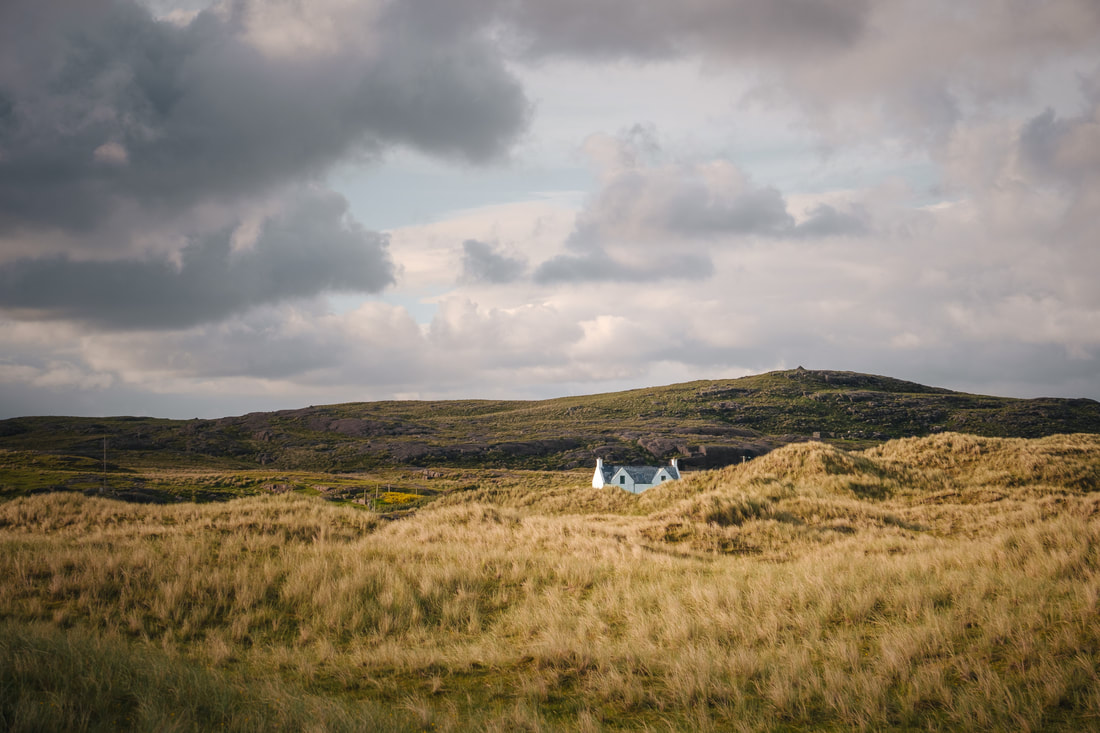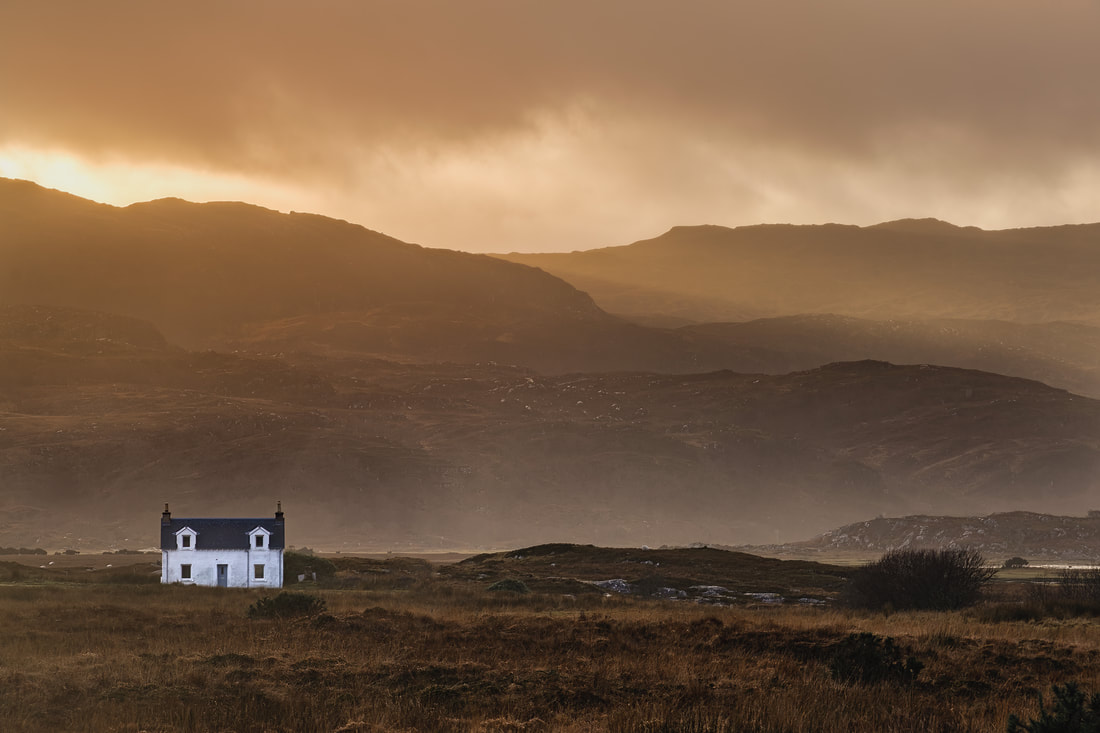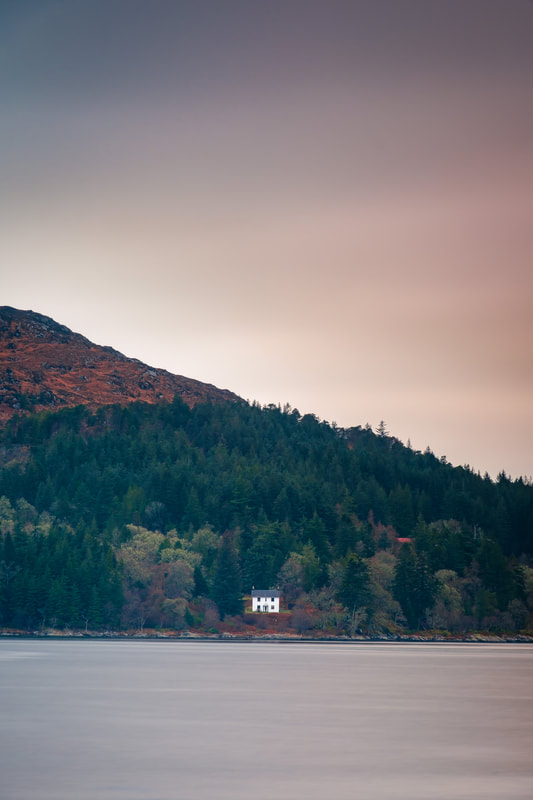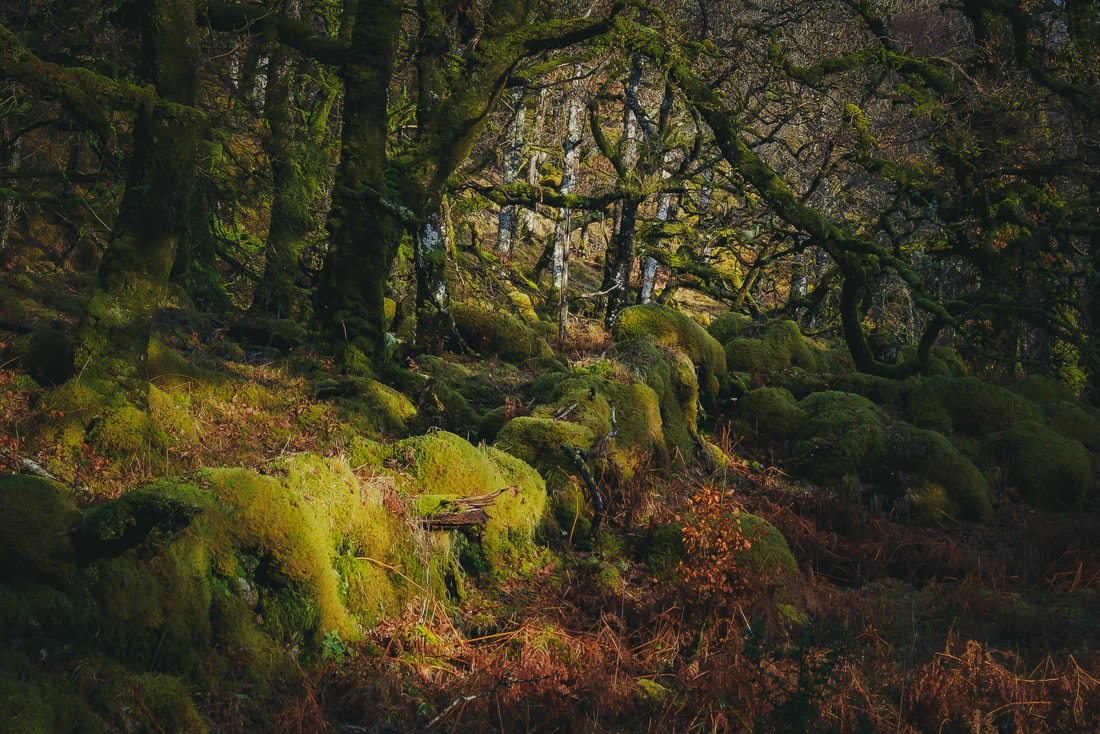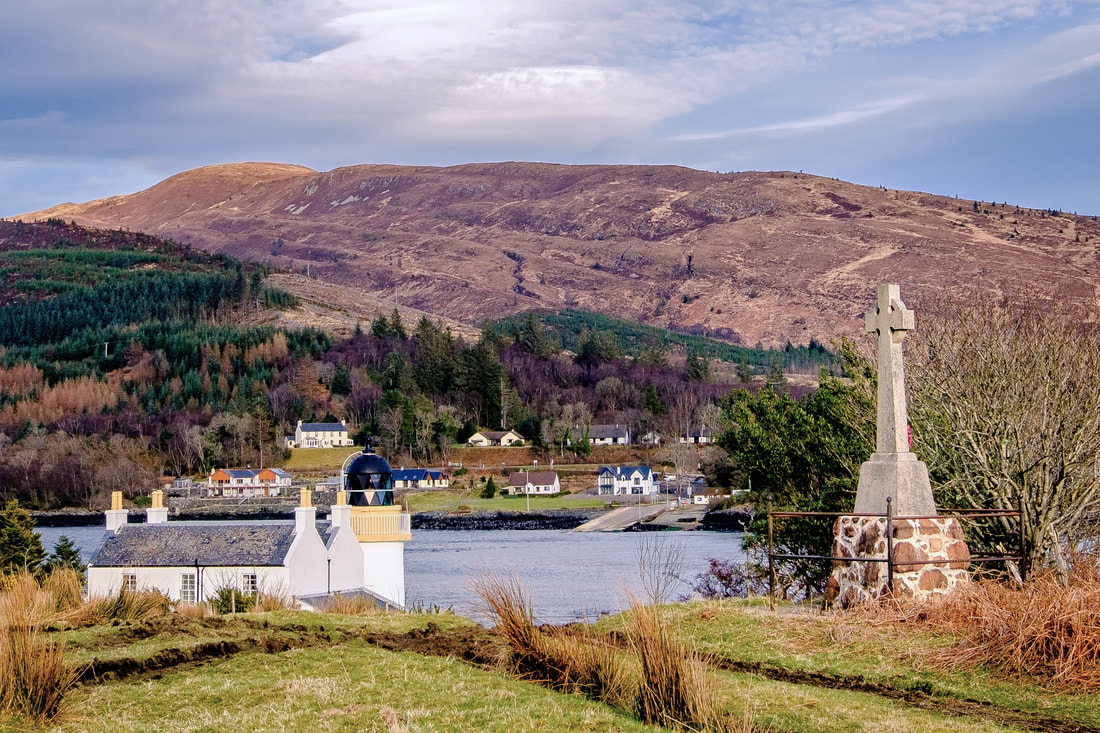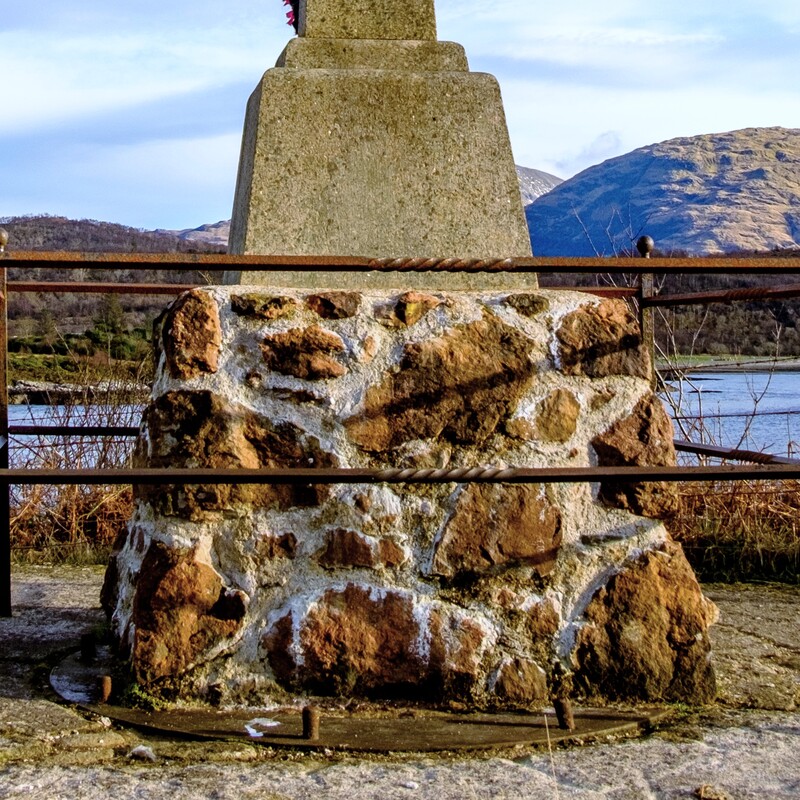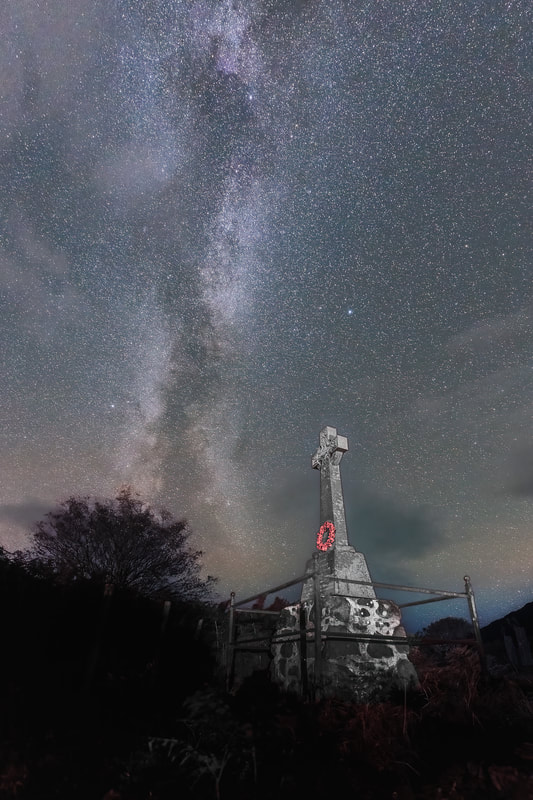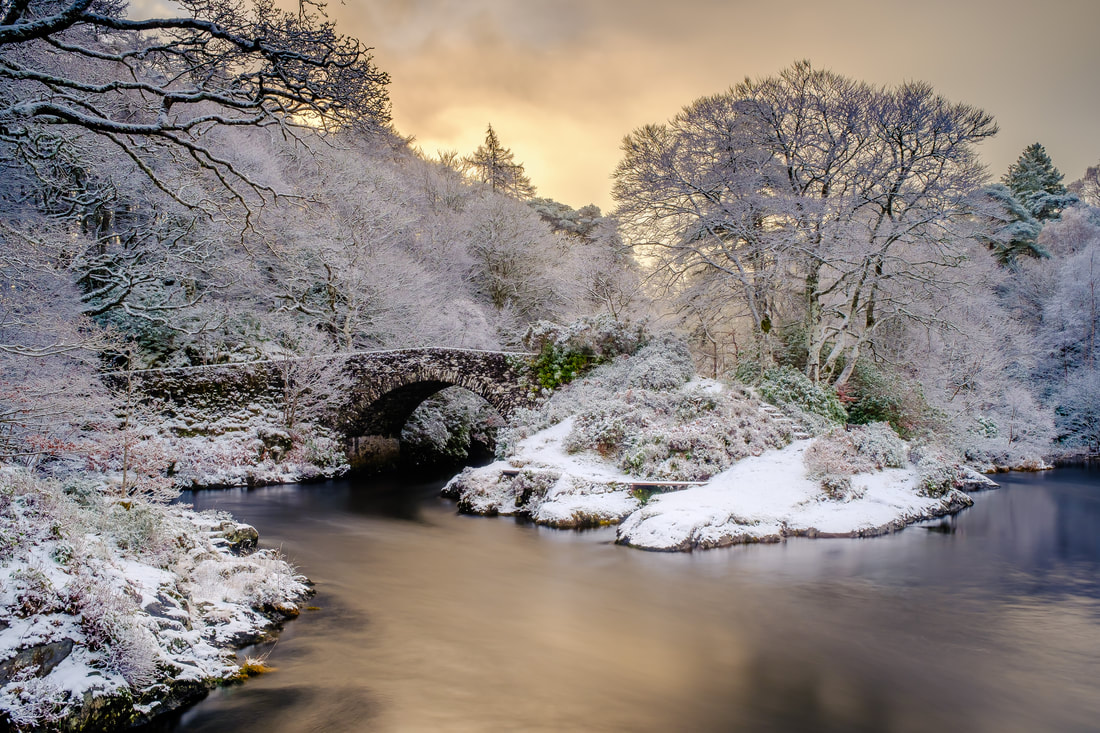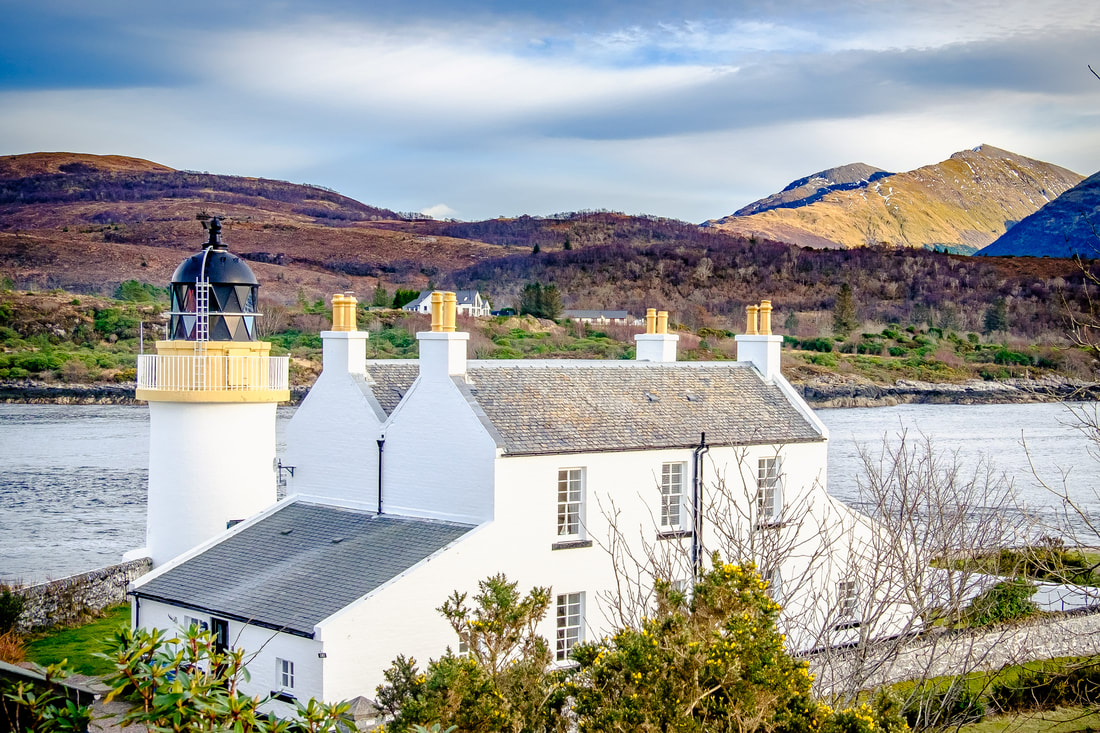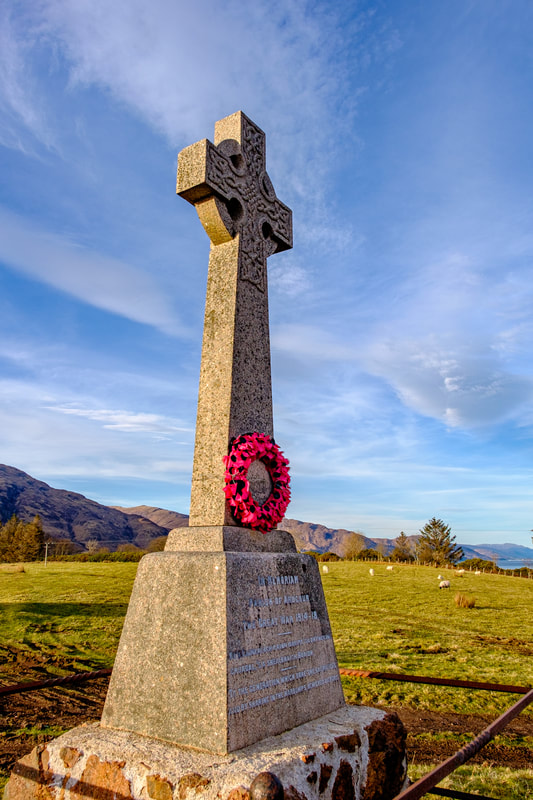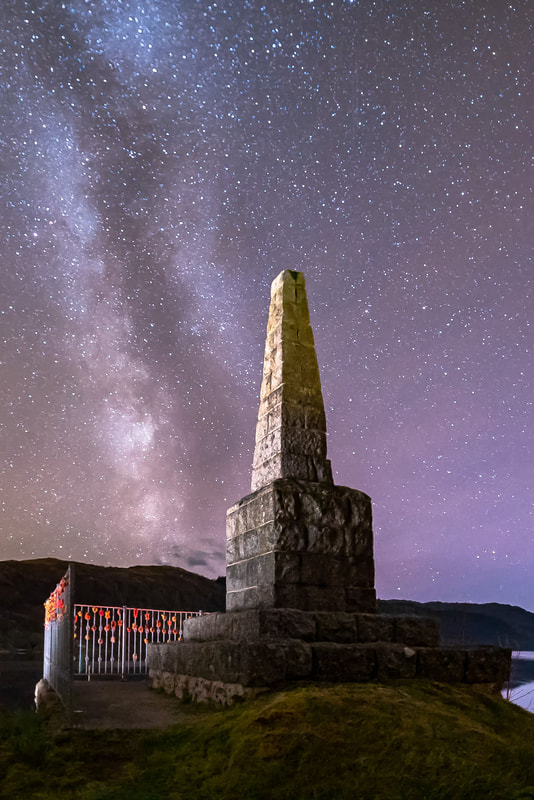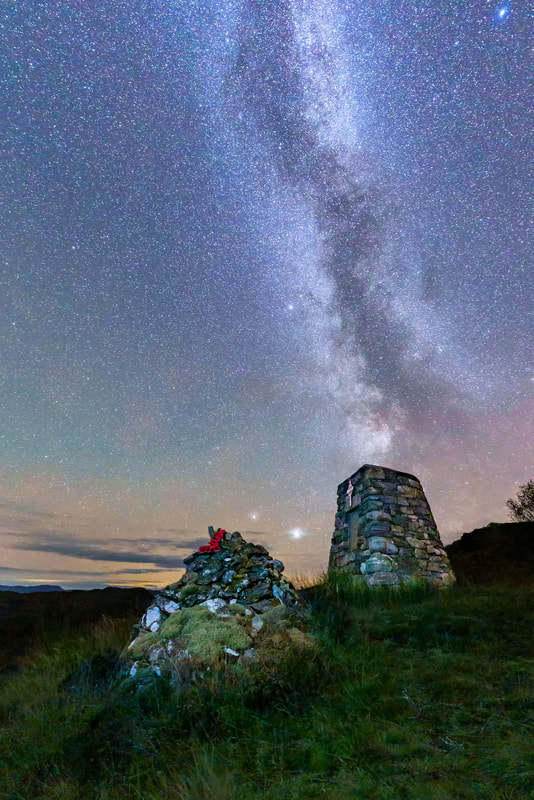|
I don’t know what it is, but I find that my eye is frequently drawn to the sight of a croft house sitting isolated in the landscape here on the Peninsula. It as if each one of these small and rather innocuous buildings has a story to tell and I guess this is why I find them so profoundly captivating. When it comes to a photograph of one, it is certainly true that a picture paints a thousand words. It’s almost as if the image is inviting me to immerse myself in a narrative that intertwines history, culture, nature, and human resilience. The narrative begins with their construction, in a time when the Scottish Highlands was sparsely populated, and life was dictated by the seasons. Back then they would have had sturdy stone walls with rounded corners to help combat the wind and treasured timbers would have supported a thatched roof. The use of locally sourced materials in these parts of the building standing as a testament to the craftsmanship and ingenuity of the crofters who had to live in harmony with their surroundings in order to survive. One can only imagine the challenges faced as the occupants practiced subsistence farming, growing crops like barley, oats and potatoes, and rearing a few cattle and sheep. However, despite the hardships, my sense is that the crofting way of life fostered a strong sense of community and mutual dependence, with the crofters working together during peak times, such as at harvest time and peat cutting. Indeed, the communal working and gatherings at important agricultural milestones would have provided opportunities for celebrating together. So, when I look at these houses, I can almost hear the murmur of voices and the echoes of laughter as the families shared stories and songs that passed from one generation to the next. The landscape surrounding the house is equally integral to its story. Whether it be rolling hillside, open moorland, sand dunes or rocky foreshore, a photograph of a croft house set against a vast and rugged landscape speaks to the symbiotic relationship between the crofters and their environment. It’s a story of respect for nature and one that changes with the seasons.
In spring, the landscape might be carpeted with blossoming wildflowers, symbolising renewal and hope. Summer’s light might cast a red glow across the walls and roof of the house, bringing a sense of warmth and security. Autumn introduces a palette of golds and oranges, a time of harvest and preparation for the winter ahead. Finally, in winter, the house, perhaps dusted with snow, stands as a beacon of warmth and safety amid the stark, cold landscape. Although stone built walls and thatched roofs have been replaced by white rendered walls and slate roofs to give us the croft houses we see today, these buildings still captivate my imagination and permeate a sense of history and heritage. To me, they are more than just structures; they are a living, breathing testament to the resilience of the people who have endured centuries of hardship and adversity to call this rugged landscape home. Such scenes speak to me and tell me a story not just of survival, but one of thriving in harmony with the land, drawing strength from the beauty and harshness of nature and this is perhaps why I find both my eye and my camera drawn to them.
0 Comments
Have you ever found yourself wandering in a place where you feel as if you are walking a fine line between this world and another? I ask because it is a feeling I often have when walking among the ancient oaks and between the moss-covered boulders of Ariundle Oakwood. I don’t know what it is about the place, but I feel that I am never too far away from the mystical realm inhabited by the faeries that gives the nearby village of Strontian or Sròn an t-Sìthein (nose of the fairy hill) its name. In my mind, it is one of the “thin places” that can be found here on the Peninsula. The concept of “thin places” has been woven into the tapestry of Celtic folklore and spirituality for centuries, being used to describe places where the boundary between the physical world and a mystical, historical or spiritual world is believed to be exceptionally thin, thus facilitating a sense of connection between the two.
In thin places, you might feel a sense of awe and heightened awareness of being in the presence of something greater than yourself and, as such, they are often characterised by an otherworldly atmosphere, where the ordinary and the extraordinary intermingle. This is certainly something I can say about Ariundle Oakwood, a place where each ancient tree and each moss-covered boulder seems to harbour mystical beings waiting to be unveiled. When you stand in a thin place you may instead find your imagination ignited by thoughts of what has been before you. This historical imagination can transport you to a different era, picturing scenes from the past as if they were unfolding right before your eyes. Camas nan Geall is a place where I get this feeling. This “Bay of the Strangers” is a fascinating place because it contains evidence of human presence that covers a period of several millennia of human history. This ranges from a Neolithic chambered cairn to deserted clearance dwellings and includes a number of things in-between. The chambered cairn in the centre of the bay may seem quite innocuous, but when you stand next to it and consider that people buried their dead there some 5000-6000 years before, you cannot help but feel a sense of what has gone before. Perhaps more poignant though, are the ruins of Torr na Mòine up on the slopes of Ben Hiant which was the settlement that was the home to the people of Camas Nan Geall before they were forcibly evicted in the 18th century so that the land could be used for a sheep farm. It’s hard to comprehend the hardship and trauma that these people suffered from being suddenly cleared from their ancestral lands by the landowner for primarily economic reasons. Finally, the Old Parish Church in Kilchoan is a place where I feel that there is a thin veil between our physical world and the spiritual world. It is a hauntingly peaceful place that seems to compel you to tread carefully and with due deference to ground that has played host to a place of worship from some 700 years. Giving Kilchoan its name, this Church of St Comghan must have been incredibly important to the local community as a place where they could come together not only to worship but to also seek fellowship and support. Indeed, a walk around the graveyard that surrounds the church to look at gravestones that date from as far back as the 14th century and as recent as the 1990’s, pays testament to just how long this “thin place” has provided spiritual succour to the community. There are many other places on the Peninsula to which I have felt a sense of the mystical, historical or spiritual and this most likely stems from my photography encouraging me to slow down and take time to get a real sense of a place before I ever think of pressing the shutter button. However, you don’t need a camera to experience the profound ways in which certain locations can inspire feelings of connectivity to a different realm. You can just slow down, look, listen and feel when you next find yourself in a place that you sense you might be connected to. I wonder how often folk have driven past the Ardgour War Memorial and never paid it much attention. This was certainly the case for me, having passed it countless times on my way to and from the Corran Ferry, until one day when I found myself with some spare time at the marshalling area on the Ardgour side of the Corran Narrows. After deciding to go for a quick walk, I found myself up on a bank just south of the lighthouse, standing beside the War Memorial and looking southwards at an expansive view of Loch Linnhe. While standing there, I spotted something that I would later learn played a small part in a huge project that is thought to have been key in bringing World War I to an end. The Ardgour War Memorial is typical of the many that you find scattered across the Highlands, consisting of a granite Celtic cross and plinth mounted on a base of what seems to be made of local stone. Whilst here, I took a moment to stand by it with my eye drawn to the wreath of red poppies that had been laid at the base of the cross and to the words inscribed on the plinth beneath it: IN MEMORIAM PARISH OF ARDGOUR THE GREAT WAR 1914-18 _____ DO'N GHINEALACH A RINN ÌOBAIRT SADH FHUILING CRUADAL, S A SHEALBHAICH BUAIDH _____ TO THE GENERATION WHICH BORE THE SACRIFICES AND BY SHARING IN THE HARDSHIPS, ACHIEVED VICTORY I then noticed that the Memorial’s stone base was sitting on what appeared to be a metal ring with several bolts protruding from it. I didn’t give them much thought at the time, but a day or two later, I couldn’t help wondering what they had been used for, so decided to try and found out.
The mines were being used in the North Sea Mine Barrage, a large minefield laid easterly from the Orkney Islands, right across the top of the North Sea to Norway with the aim of preventing the U-Boats based in Germany from making their way out into the Atlantic to attack the convoys that were bringing supplies from the United States to the British Isles.
I took these words for the image title from the seventh stanza of the poem, “For the Fallen” by Laurence Binyon, which reads:
“As the stars that shall be bright when we are dust, Moving in marches upon the heavenly plain, As the stars that are starry in the time of our darkness, To the end, to the end, they remain.” The poem is more commonly known for its third and fourth stanzas as they are often recited at Remembrance Day services as what is termed the "Ode of Remembrance", ending with the familiar words “We will remember them”. Despite the words of these two stanzas being extremely thought provoking, I find the words of the seventh stanza incredibly moving because there is such strong sense of poignancy to them. I guess that’s why I used them as the title for this image. It’s December, the first month of winter and despite the temperate oceanic climate we have here on the Peninsula, we have had some pretty cold weather and some snow falling down at low levels, but not quite as much as shown in the image below featuring snow covered trees around the Old Shiel Bridge. It is also just over a week until Christmas Day and peoples’ attention has now turned towards the festive celebrations and making preparation for gathering with friends and family. However, you may be surprised to know that such celebrations are a relatively recent occurrence, and that Christmas was banned in Scotland for almost 400 years Celebrations at this time of the year all started back in the Neolithic period, or New Stone Age, when Celtic Pagans celebrated the Winter Solstice. It falls on, or around the 21st of December each year and marks the shortest day of the year and the celebrations were held to appease the gods to allow the sun to return and have the days get longer, warmer and brighter. About 3000 years later, in the late 700s AD, the Vikings began raiding Scotland, eventually beginning to settle here from the 8th century onwards. In doing so, they brought their own way of celebrating the Winter Solstice, which they referred to as Jól and became known as Yule. Their Yule celebrations would last for around 12 days, during which they would light bonfires, tell stories, drink ale and make sacrifices to the gods to earn blessing on the crops that would be grown when the warmer days returned. As Christianity arrived, Yule gradually became the Christian celebration that we now refer to as Christmas and Yule celebrations were held in all parts of Scotland where the Catholic Church held authority. Then, in 1560, Scotland split from the Catholic Church and formed the Presbyterian Church of Scotland (the Kirk) in what was known as the Scottish Reformation. With this, came a change in religious thought, and any activity that could be seen as extravagant, or as celebrating superstitious ideals, was heavily frowned upon. This included the celebration of Yule and finally, after years of increasing discord, the Scottish Parliament passed a law in 1640 that made celebrating the ‘Yule vacations’ illegal. The ban remained in place until 1712, when it was officially repealed, but the powerful Kirk continued to frown upon any festive celebrations. In these times there was no public holiday on Christmas Day and punishments for singing Christmas carols, baking Yule bread and any other such things were extremely harsh. It was because of this that Hogmanay and New Year celebrations became so important in Scotland.
This situation continued for many years until a change in attitudes most likely caused by the commercialisation of Christmas, led to Christmas Day becoming a public holiday in 1958 and Boxing Day eventually becoming a public holiday in 1974. Some argue that this commercialisation was driven by the introduction of UK wide television broadcasting in the early 1950s and that that the pace of it increases year on year. It certainly does seem like we see Christmas decorations and sales promotions appearing earlier each year. The way we celebrate Christmas has also changed. It has moved away from religiously oriented traditions that were deeply rooted in Christianity and Viking culture, becoming more of a secular event in recent years, where the focus seems to be less religious and more about spending time with friends and family. However, whatever your views are on what Christmas should and shouldn’t be, the 25th of December 2022 will only be Scotland’s 65th Christmas holiday in 382 years, so I wish you all a Blythe Yule and hope that it brings happiness and joy to you and your family. With some time to spare after travelling back across the Corran Narrows on the ferry, I found myself up at the Ardgour War Memorial looking at signs of something that had gone before which had been a small part of a huge military project that is thought to have played a key role in bringing World War I to an end …. Time on my HandsLast week, I found myself with an unexpected hour or so to spare at Corran Point, so decided to go for a walk and find the Ardgour War Memorial, which is located up on a bank just south of the lighthouse and above the road. The main reason for doing this was to scout out the location in advance of me going there at some point after dark to photograph the Memorial under the stars. This is something that I do when preparing for most of my night shots as it is so much easier to figure out a composition in daylight than it is in the pitch dark. Having walked from the Corran Ferry, I reached the bend in the road by the Lighthouse and followed a track up into a field beyond a metal gate. I found the War Memorial at the top of a bank overlooking Loch Linnhe, with expansive views all the way down its full length to the south. The Memorial itself is typical of the many that you find scattered across the Highlands, consisting of a granite Celtic cross and plinth mounted on a base of what seemed to be made of local stone.
Gradually, I began thinking ahead to my future shot of the War Memorial under the stars and, eventually, I began looking at different shot angles of the Memorial to see if I could find some compositions that might work for the photograph that I had in mind. My plan is to take it later in the year when the Milky Way will be at its best, with its cloudy core above the horizon in the south to south-west sky. My aim is to produce something similar to these two shots that I’ve taken of the Strontian and Moidart war memorials in previous years. While doing this, I noticed that the Memorial’s stone base was sitting on what appeared to be a metal ring with several bolts protruding from it. You can see the metal ring and bolts in the picture below and the more that I thought about them, the more I couldn’t help wondering what they had been used for. Playing on My MindThis played on my mind for a day or two, leading me to do a bit of research to find out more about them. After looking at a few sources, I found some information in the Highland Historic Environment Record, that suggested that a gun battery was built on that spot in 1917, to provide protection for the United States ships unloading naval mines at Corpach that were then transported in smaller boats through the Caledonian Canal to the US Naval Base at Inverness. Further research uncovered a report titled “The Built Heritage of the First World War in Scotland” that was commissioned by Historic Scotland which confirms that the gun battery was built there and that it comprised two 15-pdr guns and one 7.5-inch howitzer bolted down onto steel rings called holdfasts, which were set into plain concrete slabs. It turns out that the War Memorial was built on one of these concrete slabs and the steel ring at its base is one of these holdfasts. The Imperial War Museum does have a photograph of the gun battery which was taken in 1918 and shows the Royal Marine Gun Crews manning the guns. In it, you can see that there is no parapet around the guns and that the ammunition for them was stored in wooden lockers close by. I’ve asked the Imperial War Museum for a licence to publish this photograph and hope to be able to share it with you at some point. A Small Part of a Big PictureAnother question came to my mind while I was researching all this – Why was the United States Navy shipping naval mines to Corpach and then transporting them up the Caledonian Canal to Inverness? Well, the answer is that the mines were being used in the North Sea Mine Barrage which was a large minefield laid easterly from the Orkney Islands, right across the top of the North Sea to Norway with the aim of preventing the U-Boats making their way from their bases in Germany and out into the Atlantic to attack the convoys that were bringing supplies from the United States to the British Isles. Laying this mine barrage was a huge undertaking and until World War II, it was the largest ever laid. It spanned the entire 230-mile width of the North Sea from Orkney and Norway and was between 15 to 35 miles wide. The Allied Forces began laying the mines in June 1918 and within a matter of a few months they had laid just over 70,000 of them at a total cost of just over £1bn in today’s money. The barrage was considered to be a great success and is credited with the destruction or damage of up to 21 U-Boats, but probably its greater effect was in shattering the morale of German submarine crews, thus helping to bring about the revolt of German seamen that marked the beginning of the defeat of Germany in World War I. Hidden HistorySo there you have it, a tiny little bit of history hidden beneath the Ardgour War Memorial in the form of a steel ring and some bolts giving a small clue of something that went before. I would never have thought that these incongruous bolts would have been part of what today would be the equivalent of a £1bn military project that is thought to have played a key part in bringing World War I to an end. A war that left more than 16 million people dead and also helped to spread one of the world’s deadliest global pandemics, the Spanish flu epidemic of 1918, which killed an estimated 20 to 50 million people. Poignant, very poignant indeed.
|
AuthorHi, Archives
July 2024
Categories
All
|
Steven Marshall Photography, Rockpool House, Resipole, Strontian, Acharacle, PH36 4HX
Telephone: 01967 431 335 | Mobile: 07585 910 058 | Email: [email protected]
Telephone: 01967 431 335 | Mobile: 07585 910 058 | Email: [email protected]
All Images & Text Copyright © 2024 - Steven Marshall - All Rights Reserved

